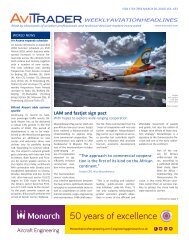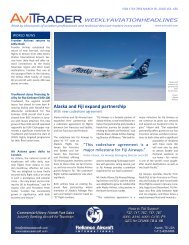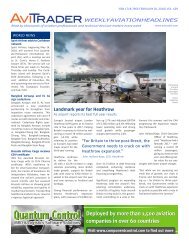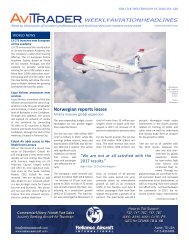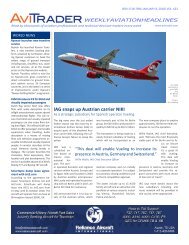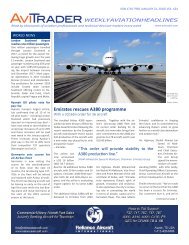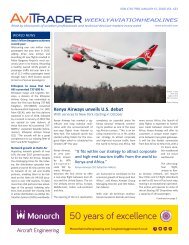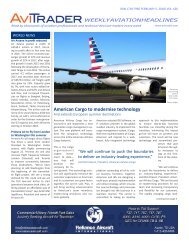AviTrader_Monthly_MRO_e-Magazine_2014-06
AviTrader_Monthly_MRO_e-Magazine_2014-06
AviTrader_Monthly_MRO_e-Magazine_2014-06
Create successful ePaper yourself
Turn your PDF publications into a flip-book with our unique Google optimized e-Paper software.
Supply chain<br />
22<br />
OEMs’ pressure on suppliers: signs of an upcoming crisis?<br />
Source: Avia Solutions Group<br />
Last year was a record one for commercial<br />
aircraft sales orders, production and backlog,<br />
with an astonishing 1 274 aircraft delivered.<br />
However, as low airfares drive airlines<br />
to buy new aircraft at lower prices, the OEMs<br />
have also been demanding suppliers to respond<br />
in kind to these pressures with significant<br />
price concessions. But the combination<br />
of pressure to trim unit costs and boost production<br />
could prove to be more disruptive<br />
than transformative.<br />
With a combined backlog of more than 10<br />
000 commercial aircraft worth close to $1<br />
trillion, both Boeing and Airbus have never<br />
been in a stronger position, particularly when<br />
it comes to negotiating with their suppliers.<br />
The manufacturers can promise suppliers<br />
10 years of recurring orders in exchange for<br />
cost reductions, improved quality and close<br />
to 100% on-time delivery. However, only the<br />
largest ones have the ability to manage their<br />
businesses on these terms.<br />
“Lately, the supplier business model has<br />
evolved into a ‘risk-sharing partner’ approach,<br />
where suppliers get paid when the<br />
OEM gets paid, and the supplier pays for<br />
and is responsible for design authority. That<br />
means the subcontractors are expected to<br />
manage a larger supply base themselves<br />
and require the same kind of skilled supply<br />
chain management personnel as the OEMs,”<br />
shares Zilvinas Sadauskas, the CEO of Locatory.com.<br />
“This is a big change, as they need to put<br />
their balance sheets at risk, invest much<br />
more of their own working capital, increase<br />
their skilled workforce and meet the new<br />
expectations of cost reductions. However,<br />
the financial, talent and operational challenges<br />
of becoming a super-supplier may<br />
not be addressable by some companies,” he<br />
added.<br />
Sadauskas continued: “One example is Boeing,<br />
which has been encouraging its vendors<br />
to optimize their supply chains and lower<br />
costs in exchange for more business. The<br />
manufacturer is using 777X participation<br />
for as much leverage as it can on the supply<br />
chain for further cost reductions. Many<br />
suppliers have indicated that a 15-20% reduction<br />
is what is expected for involvement<br />
on the 777X.”<br />
OEMs have started taking some design authority back in-house.<br />
Moreover, a push for reduction in supply<br />
chains cost is likely not to ease up even as<br />
the economy improves, as found by a survey<br />
by Canaccord Genuity. As a result, more and<br />
more suppliers have been indicating that<br />
they may be prepared to walk away from<br />
some business. Boeing’s switch from United<br />
Technologies Aerospace Systems to Heroux-<br />
Devtek in landing gear supply solutions,<br />
when the price concessions became too extreme<br />
for the former, is one of the proofs of<br />
the trend according to Sadauskas.<br />
“Large airframe manufacturers are relying on<br />
very small companies as single sources for<br />
some key parts and sub-assemblies. When<br />
such small players are asked at the same<br />
time to invest in new capabilities and share<br />
the risks for new programmes, they become<br />
overstretched both financially and operationally.<br />
Such companies can spin out of control<br />
quickly—and run out of cash—forcing<br />
the OEMs to intervene, even if it is only a<br />
relatively small business producing one part<br />
for a single programme.”<br />
Photo: Locatory.com<br />
One such example is Latecoere, which became<br />
so undercapitalized that it almost<br />
went bankrupt in 2010. Even today, its debtto-capital<br />
ratio is over 170%, comments the<br />
CEO of Locatory.com.<br />
The other side of the coin is that many of the<br />
smaller suppliers may be acquired to enable<br />
the surviving bigger companies to gain better<br />
economies of scale. With fewer suppliers<br />
to work with, OEMs may find that vendors<br />
will be able to control prices for components<br />
and systems better, due to less competition.<br />
This could lead to manufacturing capacityrelated<br />
delays, OEM margin pressure or supplier<br />
price increases.<br />
“Of course, some progress has been noticeable,<br />
as OEMs have started taking some design<br />
authority back in-house and providing<br />
financial support to help certain suppliers.<br />
However, the fact is that beyond the unprecedented<br />
backlogs, the business reality down<br />
the supply chain actually displays a very different<br />
picture: too many weaknesses embedded<br />
in the system are not being addressed<br />
properly. While the manufacturers are trying<br />
to make the most of favorable environment,<br />
it’s important that the industry focuses of<br />
not allowing the system to overheat,” concludes<br />
Sadauskas.<br />
<strong>AviTrader</strong> <strong>MRO</strong> - June <strong>2014</strong>





